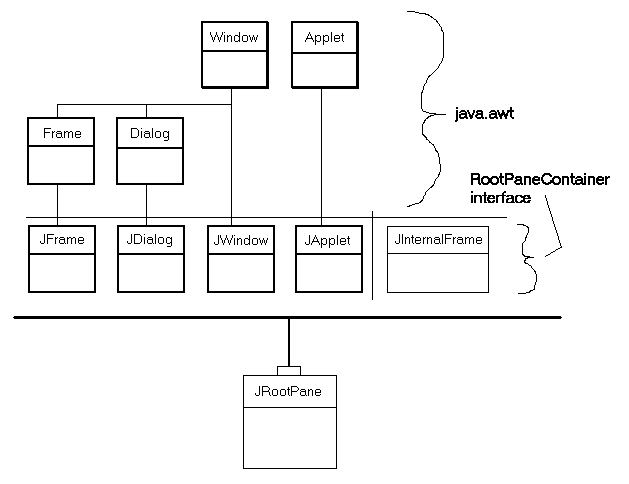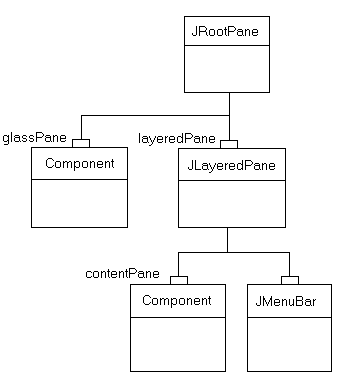JRootPane (Java Platform SE 8 ) (original) (raw)
A lightweight container used behind the scenes byJFrame, JDialog, JWindow,JApplet, and JInternalFrame. For task-oriented information on functionality provided by root panes see How to Use Root Panes, a section in The Java Tutorial.
The following image shows the relationships between the classes that use root panes.

The "heavyweight" components (those that delegate to a peer, or native component on the host system) are shown with a darker, heavier box. The four heavyweight JFC/Swing containers (JFrame, JDialog,JWindow, and JApplet) are shown in relation to the AWT classes they extend. These four components are the only heavyweight containers in the Swing library. The lightweight containerJInternalFrame is also shown. All five of these JFC/Swing containers implement theRootPaneContainer interface, and they all delegate their operations to aJRootPane (shown with a little "handle" on top).
Note: The
JComponentmethodgetRootPanecan be used to obtain theJRootPanethat contains a given component.

The diagram at right shows the structure of a JRootPane. A JRootpane is made up of a glassPane, an optional menuBar, and a contentPane. (The JLayeredPane manages the menuBar and the contentPane.) The glassPane sits over the top of everything, where it is in a position to intercept mouse movements. Since the glassPane (like the contentPane) can be an arbitrary component, it is also possible to set up theglassPane for drawing. Lines and images on theglassPane can then range over the frames underneath without being limited by their boundaries.
Although the menuBar component is optional, the layeredPane, contentPane, and glassPane always exist. Attempting to set them to null generates an exception.
To add components to the JRootPane (other than the optional menu bar), you add the object to the contentPane of the JRootPane, like this:
rootPane.getContentPane().add(child); The same principle holds true for setting layout managers, removing components, listing children, etc. All these methods are invoked on the contentPane instead of on the JRootPane.
Note: The default layout manager for the
contentPaneis aBorderLayoutmanager. However, theJRootPaneuses a customLayoutManager. So, when you want to change the layout manager for the components you added to aJRootPane, be sure to use code like this:rootPane.getContentPane().setLayout(new BoxLayout());
If a JMenuBar component is set on the JRootPane, it is positioned along the upper edge of the frame. The contentPane is adjusted in location and size to fill the remaining area. (The JMenuBar and the contentPane are added to thelayeredPane component at theJLayeredPane.FRAME_CONTENT_LAYER layer.)
The layeredPane is the parent of all children in theJRootPane -- both as the direct parent of the menu and the grandparent of all components added to the contentPane. It is an instance of JLayeredPane, which provides the ability to add components at several layers. This capability is very useful when working with menu popups, dialog boxes, and dragging -- situations in which you need to place a component on top of all other components in the pane.
The glassPane sits on top of all other components in theJRootPane. That provides a convenient place to draw above all other components, and makes it possible to intercept mouse events, which is useful both for dragging and for drawing. Developers can use setVisible on the glassPane to control when the glassPane displays over the other children. By default the glassPane is not visible.
The custom LayoutManager used by JRootPane ensures that:
- The
glassPanefills the entire viewable area of theJRootPane(bounds - insets). - The
layeredPanefills the entire viewable area of theJRootPane. (bounds - insets) - The
menuBaris positioned at the upper edge of thelayeredPane. - The
contentPanefills the entire viewable area, minus themenuBar, if present.
Any other views in the JRootPane view hierarchy are ignored.
If you replace the LayoutManager of the JRootPane, you are responsible for managing all of these views. So ordinarily you will want to be sure that you change the layout manager for the contentPane rather than for the JRootPane itself!
The painting architecture of Swing requires an opaqueJComponent to exist in the containment hierarchy above all other components. This is typically provided by way of the content pane. If you replace the content pane, it is recommended that you make the content pane opaque by way of setOpaque(true). Additionally, if the content pane overrides paintComponent, it will need to completely fill in the background in an opaque color inpaintComponent.
Warning: Swing is not thread safe. For more information see Swing's Threading Policy.
Warning: Serialized objects of this class will not be compatible with future Swing releases. The current serialization support is appropriate for short term storage or RMI between applications running the same version of Swing. As of 1.4, support for long term storage of all JavaBeans™ has been added to the java.beans package. Please see XMLEncoder.